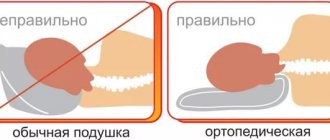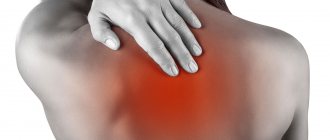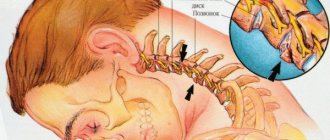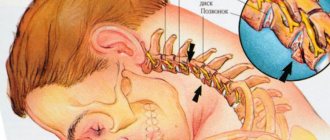Diseases associated with spinal dysfunction are most often observed with physical inactivity. Osteochondrosis in this case is no exception. At the initial stages of pathogenesis, the disease occurs without a pronounced clinical picture. Over time, the symptoms of the disease become more pronounced. With osteochondrosis, people often complain of insomnia, headaches, dizziness, discomfort in the chest and neck. How to sleep with cervical osteochondrosis to ensure healthy sleep, says candidate of sciences, founder of the “Club of Former Hypertensive Patients”, author of effective methods for treating spinal diseases, doctor with many years of experience A.Yu. Shishonin.
Important.
Correctly selected posture during sleep significantly reduces the load on the neck. Thus, you independently provide yourself with micro-restoration of the spine.
What are the benefits of an orthopedic pillow?
A healthy person can sleep on any surface and feel good - on a soft pillow, on a hard one, or without one at all. For a patient with osteochondrosis, finding a comfortable sleeping position is an art.
An orthopedic pillow helps relax the muscles of the back and neck, relieves vascular constrictions and allows you to restore blood circulation. It's easier to fall asleep on it than on a regular one.
Doctor's advice - Patients with osteochondrosis go to great lengths to find a comfortable position for sleeping, says neurologist Alexander Ishkin. “For example, they sleep on two pillows almost sitting up, and this only makes things worse for themselves. If the head is thrown back and the blood vessels are compressed, how can this be useful? No. It is better to choose a suitable orthopedic pillow.
No orthopedic product for cervical osteochondrosis replaces drug treatment and gymnastics! But a specialized pillow can make it easier to fall asleep, support the cervical spine in the correct position and enhance the healing effect of physical exercise and medications.
How to choose the right mattress?
A properly selected mattress is not only a comfortable rest, but also an investment in your own health. In particular, in the musculoskeletal system. For the purposes of both treatment and prevention of cervical osteochondrosis, it is worth choosing orthopedic options and changing them every 8-10 years. The size of the product should take into account the height and weight of the sleeper, the degree of rigidity should be moderate.
An excessively hard or soft mattress provokes a slow but rapid curvature of the spine and the development of the disease. On a soft bed, the spine will bend, disrupting normal blood circulation. A rigid frame will result in constant muscle tension. The best option is a latex memory foam mattress that can remember the curves of the body.
Types of pillows
Having heard the expression orthopedic pillow for a sore neck, many imagine only a wave-shaped model. In fact, orthopedic models are different. Which one should I buy?
Roller
DreamLine Dream lux pillow in cotton cover
An orthopedic pillow with a bolster is well suited for people with any type of osteochondrosis. It is especially appreciated by patients suffering from straightened cervical lordosis. They have a straight neck without natural curves. By pressing on the cervical vertebrae, the roller returns them to the correct place and forms the desired cervical curve. This not only helps you fall asleep faster, but also relieves stress and restores normal blood flow.
| Moderately soft | Anatomical | Memory effect | On the side | On the back |
Crescent
Model Pillow Tempur Sonata Small crescent shaped pillow
Recommended for people who have pain not only in their neck, but also in their shoulders, because it supports both the head and the back. Must be made of soft materials that do not lose their shape. For example, Tempur memory foam. It maintains the spine in the correct position and does not compress soft tissues, since it does not exert back pressure on the body.
| Moderately soft | Tempur with memory | On the side | On the back | On the stomach |
Rectangular
Lonax Middle Latex pillow height 12 cm
An orthopedic pillow is a pillow that supports the spine in the correct position. Not all orthopedic pillows have a wave shape; there are also rectangular ones. The main thing is the material from which the pillow is made. Elastic natural latex, comfortable memory foam or Tempur help you find a comfortable position and fall asleep. Lonax Middle Latex made from natural latex has all these advantages.
| Average | Standard | Latex | On the side | On the back |
With a massage effect
Dreamline Massage. Model height: 12 cm
With osteochondrosis, the cervical spine is deformed, the vertebrae compress the nerve endings, so the arms or shoulders may go numb. A pillow with a textured surface has a light massage effect that helps restore blood circulation and relieve tension in the back of the head and shoulders. A light massage is beneficial for any person, and if you have problems with the spine, it is simply necessary. An example of such a pillow is Dreamline Massage made of polyurethane foam.
| Moderately hard | Anatomical | Claim. latex | On the side | On the back |
With a notch in the middle
Tempur Classic Pillow with Center Hole
An anatomical pillow with a notch supports the cervical spine in the correct position without compressing the vertebrae. Such models usually consist of memory, as soon as a person lies down on the pillow, it immediately takes the shape of his body. We offer a model made from Tempur, an advanced memory foam. Reacts to heat and pressure, as if enveloping the neck. It is so comfortable to sleep on it that for several years of sales there has not been a single dissatisfied customer.
| Tempur with memory | On the side | On the back | On the stomach |
With shoulder recess
Magniflex Memoform Superiore Deluxe Comfort with shoulder recess
People with cervical osteochondrosis have difficulty finding a comfortable sleeping position. Many people sleep half-turned - this is a cross between sleeping on their side and on their stomach. For such cases, you need a model with a recess for the shoulder. There is no need to put your hand on the pillow; the pillow itself will support your head at the desired height. Memory does not compress soft tissues, which is especially valuable during an exacerbation of the disease.
| Moderately soft | Anatomical | Memory effect | On the side |
Under the lower back
Tempur lumbar pillow Bed Back Support. helps the spine to take the correct position
People with cervical osteochondrosis often have pain not only in their neck, but also in their entire back. A triangular pillow under the lower back will help you take a comfortable position and relieve the load on the sacral region. The triangular-shaped model supports the natural curves of the spine and prevents the appearance of clamps between the intervertebral discs.
Pros and cons of anatomical models
Do you need an anatomical pillow? If you often feel pain in the morning, toss and turn at night, snore, sleep poorly or suffer from osteochondrosis, the answer is clear – you need it. The benefits of anatomical pillows are tangible: they are needed to ensure sound and healthy sleep, help get rid of snoring, normalize blood flow and lymph circulation, and create physiological support for the neck and back. And this is an excellent prevention of diseases associated with the spine.
As for the disadvantages, the main one is rigidity, which you need to get used to. In general, harm from anatomical models is only possible if you choose the wrong product.
How to choose the right pillow
When choosing a pillow for cervical osteochondrosis, pay attention to such characteristics as hardness, height, filler material and size.
If you've slept on a soft down pillow your whole life, be prepared for the fact that an orthopedic one may seem uncomfortable at first. This is not necessary, but possible. Don't give up on the orthopedic model, try to get used to it. After two or three days, your feather pillow will no longer seem comfortable.
Height
When your neck hurts, you want to raise your head as high as possible and sleep on two pillows. You shouldn't do this. Sleeping on a very high pillow leads to displacement of the cervical vertebrae.
You can’t sleep without a pillow at all - your head falls back and your muscles become overstrained.
For an adult, a pillow with a height of 12 cm is suitable.
Fillers
- Natural latex. Elastic foam material, which is obtained from the juice of the hevea tree. Slightly springy, creates a pleasant surface. Can be of different hardness.
- Memory. Memory foam conforms to the shape of the human body without resistance. It does not put pressure on the neck and shoulders, so it is easy to find a comfortable sleeping position.
- Tempur. An improved type of memory. Viscoelastic foam reacts to temperature, follows the shape of the human body, while maintaining the spine in the correct position.
- Soy foam. A high-tech product based on natural soy foam with elastic additives. There are several types of soy foams, they differ from each other in the level of hardness and elasticity.
- PPU. Budget artificial foam, which, nevertheless, performs its functions and supports the cervical vertebrae in the correct position. Orthopedic pillows made of polyurethane foam monolith are available in the form of a wave or a roller.
| Material | Naturalness | Large selection of shapes | Budget cost | Hypoallergenicity | Long service life | Does the material adapt to the shape of the body? | Increased comfort |
| Tempur | — | + | — | + | + | + | + |
| Natural latex | + | + | — | + | + | — | + |
| Memory | — | + | — | + | — | + | + |
| PPU | — | — | + | + | — | — | — |
| Soy foam | + | + | — | + | + | + | + |
How does the disease manifest itself?
The cervical region is anatomically located between seven intervertebral discs, the task of which is to ensure free rotation of the head. This part of the body is characterized by weak, inactive muscles, the condition of which is only aggravated by an inactive lifestyle. However, this does not prevent them from taking on regular loads, which leads to various pathologies. The main signs of a progressive disease remain:
- headache;
- deterioration of hearing and vision;
- the appearance of ringing and noise in the ears;
- destruction of tooth enamel;
- night snoring, whistling;
- frequent dizziness, lightheadedness;
- violation of movement coordination.
The main reasons for the development of the disease today are known to everyone: lack of strength loads, inactivity, poor posture, inflammatory processes (purulent infections), congenital pathologies, serious injuries and a decrease in metabolic processes that manifest themselves as a result of natural aging of the body.
The first symptoms of intervertebral disc dysfunction are pain in the back of the head, clicking sounds and discomfort when rotating the head. Neglecting these symptoms leads to other, much more serious manifestations.
TOP 3 popular manufacturers
- Tempur. A company from Denmark that developed and patented the material of the same name. The pillows are characterized by high quality, good orthopedic properties, belong to the premium class and have an above-average price.
- Ascona. A large Russian company with its own laboratory. Askona specialists develop new models of pillows, conduct tests and put the models into production.
- Ormatek. One of the largest Russian pillow manufacturers. Exports its products to Europe and Asia.
Osteochondrosis - symptoms and complications
The disease has several stages and varieties. During inflammation, the cartilage tissue between the vertebrae is destroyed. All nerve endings are set in motion around the source of inflammation. They, in turn, harm blood vessels. Thus, the entire intervertebral space becomes involved in a harmful process, gradually collapsing and becoming thinner. As a result, tissue oxygen starvation occurs.
Complex forms of osteochondrosis require hospitalization and can lead to disability. Therefore, it is important to detect pathological changes in time. The symptoms of the disease are as follows:
- Pain in the neck, becomes stronger during movement (a sign of the initial stage).
- General weakness and dizziness (caused by changes in blood pressure).
- Nausea, sometimes vomiting (due to poor blood flow).
- Severe weakness, on the verge of fainting (occurs due to poor nutrition of the brain).
- Low pressure or sudden changes.
The listed symptoms are sufficient reason to visit a neurologist. Many people neglect going to the doctor. But this is the wrong position. Cervical osteochondrosis can be treated, although it will take a lot of time.
In addition to severe pain that occurs during sleep, the disease can cause other complications. The most unpleasant of them is a herniated spine. Deterioration of the intervertebral space leads to protrusion of the disc nucleus. This entails a sharp deterioration in blood circulation in the cervical spine. Which, in turn, is very dangerous - oxygen will flow to the brain in minimal quantities. Plaques also begin to form in the vessels, which will further impede the outflow of blood.
The best pillow according to customer reviews
BeautySon Memory Plus model with a light massage effect, 12 cm high
The best-selling pillow for osteochondrosis in our store is BeautySon Memory Plus. It’s easy to understand why buyers choose it:
- The orthopedic shape supports the spine in the correct position with a wave.
- Memory foam does not put pressure on soft tissues and does not compress blood vessels.
- A light massage effect restores blood flow.
- The affordable price (just over 3,000 rubles) makes the pillow affordable for most residents of Russia.
| Soft | Anatomical | Memory effect | On the side | On the back |
If the pathology worsens
If progression of cervical osteochondrosis is observed, the patient sleeps poorly: has difficulty falling asleep, is irritable in the morning, often wakes up at night, gets up early, feels unreasonably tired. He suffers from sharp pain in the neck, discomfort and stiffness in his movements. In this case, you should sleep exclusively on one side; in such a position that the shoulder is pressed into the mattress. This position will allow the back to take the most correct shape, and the spinal column will be straight and relaxed. If you observe a sharp exacerbation of the disease, then stop using the roller. And don’t delay your visit to a specialist.
Why is sleeping without a pillow harmful?
Giving up a pillow may well be harmful both in terms of sleep quality and in terms of deterioration in well-being:
- Discomfort – many people who are accustomed to a pillow find it uncomfortable to sleep for a long time without it. They intuitively try to put their hand under their head and often wake up. This leads to decreased performance, and sometimes to various diseases;
- Problems with appearance - in order to detect mattress imprints on your face after waking up, you need to place at least a thin pillowcase or towel under your head;
- Osteochondrosis - an even body position does not allow you to fully relax the neck muscles and relieve the tension that has accumulated during the day. As a result, degenerative processes begin in the cartilage between the vertebrae, the roots are compressed, and the neck swells. All this contributes to the development of osteochondrosis, the appearance of painful sensations due to unnatural body position;
- Poor blood circulation in the brain - according to experts, sleeping on a flat surface can disrupt blood flow in the vertebral arteries, including due to muscle tension;
- Snoring – without a pillow, a person often sleeps with his head thrown back. In this position, the tongue falls back and blocks the access of air to the respiratory tract. This may well cause snoring, even in those who have not encountered such a problem before;
- The inability to sleep on the side - and in this position the head is tilted too much in relation to the mattress, because of this the blood rushes to it too much, and unpleasant pulsating sensations appear. By morning, a headache usually appears.
In some situations, sleeping without a pillow is strictly not recommended. For example, in case of heart failure and congestion in the lungs, predisposition to ischemic stroke, it is necessary to place a pillow or cushion under the head at night. You cannot sleep on a flat surface if you have glaucoma - the pressure in the eyes increases dangerously, and when using a pillow, the head is in an elevated position, which helps reduce eye pressure.
Why is correct sleeping position important?
There is a direct relationship between the severity of symptoms of osteochondrosis and a person’s position during sleep. The fact is that it is during this period that a person’s back and spine relax and rest as much as possible. If you neglect this rule, then in the future you may encounter displacement of the intervertebral discs and the occurrence of pinching.
The human spine is surrounded by ligaments, nerves, blood vessels and muscles. The central nervous system is responsible for the functioning of muscles, sending its impulses to them. In the absence of treatment and uncomfortable sleep, destructive processes in the intervertebral cartilage also affect nearby tissues.
Is it useful to sleep on the floor with osteochondrosis?
In many Eastern cultures, sleeping on the floor is considered beneficial for human health. The Chinese have long preferred to sleep on hard floors, following the traditions of their ancestors. The Eastern Slavs also slept on bare boards for a long time, and then invented straw-filled mattresses and feather beds.
However, debates about the benefits of sleeping on a hard surface are still going on: some argue that it is the hard surface that helps increase vitality, others talk about the non-physiological position of the spine, especially in the presence of diseases. Experts say that sleeping on a hard surface (the floor) is much healthier than sleeping on a soft feather bed. However, a number of conditions must be met:
- It is better to put a thin, hard mattress or a light blanket on the floor. You can use a gymnastic mat.
- It is recommended to sleep in a supine position. In this case, you can slightly bend your knees (this will relieve tension from the pelvis and evenly distribute body weight).
- Try to lie down so that your body does not experience discomfort.
- You can use a small orthopedic pillow.
- Locate your sleeping area away from radiators.
For osteochondrosis, orthopedists still recommend using special orthopedic mattresses that provide the spine with the necessary support throughout the night. Such mattresses are quite expensive, but their benefits are invaluable for the injured spine.
Prevention methods
To avoid worsening the condition, you need to know a few important rules:
- Proper sleep. Includes proper body positioning during sleep, a good pillow and mattress.
- Morning exercises. Just 10 minutes of simple exercise a day will significantly reduce the risk of complications.
- Balanced diet. It is important to include foods with calcium, magnesium and iron in your diet. They enrich joints and tissues, increasing their resistance to damage.
- Massage. Gentle massaging movements of the neck area will improve blood flow. It is important to do everything carefully so as not to cause harm. You can use special ointments and gels. Massage is contraindicated in the acute stage of the disease.
Who can and should sleep without a pillow?
Whether an adult can sleep without a pillow is a rather controversial issue. This option can be practiced periodically when you want to change the position of your head during sleep. But if the slightest discomfort occurs, you need to use the pillow again.
The only people who definitely benefit from not having a pillow at night are very young children. Their spine is designed in such a way that neck support is not required during sleep. Quite the contrary: its absence helps the future curves of the spine to form correctly and strengthen the neck muscles.
According to doctors, the best option for a child is to sleep without a pillow for up to six months. Next, you can place a folded diaper under your head, and after a year, try a flat orthopedic pillow. In general, you should focus on the baby’s behavior: if he sleeps well without a pillow and doesn’t act up for no reason after waking up, it means that at this stage you can completely refuse this accessory.
Pay attention to the pillow!
A good option is an orthopedic pillow with a moderately dense cushion around the edge. Lie down on it so that your shoulders are on the mattress, your neck is on the bolster, and your head is on the pillow. This will be the correct position for the neck. The muscle corset will relax, but remain in moderate tone. And blood will flow freely to the brain cells.
If you prefer a regular pillow, you should always understand that its primary task is to support the neck, and many people think that it supports the head. A traditional accessory, if it is flexible and lightweight, will completely replace its orthopedic counterpart.
However, there are a few “buts” here! The shape must be oblong, about 40 centimeters on the short side. Place only your neck and head on such a classic pillow. Place a sufficient portion of the volume of the pillow under your neck. It's the most important!
As you can see, there is a lot to learn here! And if it is true that without deep sleep there is no health, then proper sleep with the correct position of the neck is good health.
How to relieve pain yourself
It is important to remember that the average weight of the head is about 9 kg, so it is so important to give your neck timely rest. If you feel tired, simply lie back in your chair, relaxing your neck, or better yet, lie down on a comfortable pillow. This will avoid cramps from overexertion. Painkillers such as Solpadeine, Aspirin, Ibuprofen and others will also help get rid of neck pain after sleep. How to take them correctly is written in the instructions for the drug.
Set of exercises
Severe acute neck pain that occurs after sleep can be eliminated through physical exercises that are aimed at improving blood flow and strengthening the neck muscles. If your neck begins to hurt after sleep, sit on a chair, straighten up and, holding your head straight, tense your muscles, then tilt your head in different directions, forward and backward, overcoming the tension. The tension needs to be held for 5-7 seconds, after which you need to rest for 10 seconds and repeat everything again. Or, while inhaling, you can press your hand on your temple so that neck resistance is created. Hold the tension for 5-7 seconds, rest for 10 seconds and repeat. You can also relax your body as much as possible, and then slowly begin to tilt your neck to one side, then to the other, so that the movements are similar to a pendulum. Repeat the exercise 10 times.
Do you need a pillow for sleeping or not?
The first pillows appeared in ancient times. There is a legend that the prototype of this item for sleeping was invented by Buddha during his wanderings. Very tired on the road, Buddha decided to rest in the shade of a large tree. He collected fallen leaves and several tufts of grass into his backpack, put the bag under his head and fell asleep. Waking up completely rested just a few hours later, the Buddha realized that his sleep was especially sound due to his comfortable posture.
The main function of the pillow these days has changed little since those ancient times - it is designed to provide a comfortable position for the head and neck, due to which the muscles will be in a relaxed state. Relaxed muscles mean good blood flow and no stress on the rest of the spine. Of course, not all pillows promote correct body position. Too high levels create excess muscle tension, while too low levels can lead to circulatory problems in the head and breathing problems.
Little nuances of a comfortable sleep
The quality of sleep directly affects a person’s well-being, especially with osteochondrosis. How to arrange a sleeping place to speed up recovery and not provoke relapses? Answers to frequently asked questions:
- Which bed is better to sleep on? Furniture must be suitable in size for a person. You need to add 20 cm to your height. The standard width of a single bed is 80 cm, a double bed is 140 cm.
- What's better to sleep on? For osteochondrosis of the cervical spine, it is better to choose a double-sided orthopedic mattress. It will provide comfort during remission of the disease and will contribute to the anatomical position in the acute stage.
- How to sleep better? If there is an exacerbation of osteochondrosis of the cervical spine, it is recommended to lie on your back. During the period of remission, you can take the fetal position.
- How many hours should you sleep? The duration of sleep is individual for each organism. According to WHO, the recommended time for night rest is from 6 to 8 hours. Chronic lack of sleep weakens the body, leads to irritability, and provokes exacerbations of various diseases.
- Why can't I sleep at night? Osteochondrosis of the cervical spine provokes compression of blood vessels and nerve roots, preventing normal blood flow. This affects the nutrition of the brain, causing headaches, insomnia, irritation, and impaired hearing and vision. Sometimes a person, on the contrary, constantly wants to sleep, depression and fatigue arise.
To spend the night comfortably, choose your bedding accessories wisely and purchase several bolsters of different shapes. They are convenient to place under the knees, lower back, around the waist and between the legs. This will provide additional support to the spine in various poses. Self-massage for cervical osteochondrosis will relax the muscles and improve blood circulation. Provide fresh air access to the room so that the body can be constantly saturated with oxygen. Good sleep is an important aspect for a person’s normal well-being and restoration of health.











